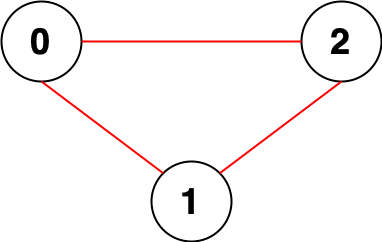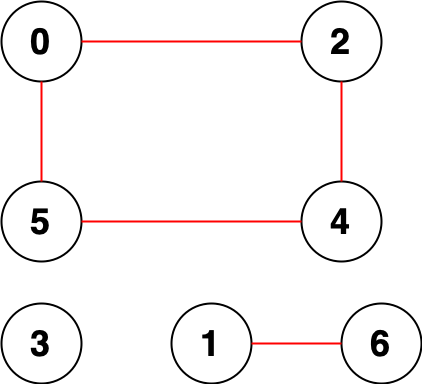You are given an integer n. There is an undirected graph with n nodes, numbered from 0 to n - 1. You are given a 2D integer array edges where edges[i] = [ai, bi] denotes that there exists an undirected edge connecting nodes ai and bi.
Return the number of pairs of different nodes that are unreachable from each other.
Example 1:

Input: n = 3, edges = [[0,1],[0,2],[1,2]] Output: 0 Explanation: There are no pairs of nodes that are unreachable from each other. Therefore, we return 0.
Example 2:

Input: n = 7, edges = [[0,2],[0,5],[2,4],[1,6],[5,4]] Output: 14 Explanation: There are 14 pairs of nodes that are unreachable from each other: [[0,1],[0,3],[0,6],[1,2],[1,3],[1,4],[1,5],[2,3],[2,6],[3,4],[3,5],[3,6],[4,6],[5,6]]. Therefore, we return 14.
Constraints:
1 <= n <= 1050 <= edges.length <= 2 * 105edges[i].length == 20 <= ai, bi < nai != bi- There are no repeated edges.
统计无向图中无法互相到达点对数。
给你一个整数 n ,表示一张 无向图 中有 n 个节点,编号为 0 到 n - 1 。同时给你一个二维整数数组 edges ,其中 edges[i] = [ai, bi] 表示节点 ai 和 bi 之间有一条 无向 边。
请你返回 无法互相到达 的不同 点对数目 。
来源:力扣(LeetCode)
链接:https://leetcode.cn/problems/count-unreachable-pairs-of-nodes-in-an-undirected-graph
著作权归领扣网络所有。商业转载请联系官方授权,非商业转载请注明出处。
思路是 DFS,可以参考 323题。我们把图建立起来之后,开始遍历每一个 node,遍历的同时我们记录每一个连通分量的大小。
举个例子,比如题目一共给了 n 个 node。对于当前我在遍历的某个 node,我去看一下他的所有邻居节点,这样我能计算出当前这个 node 所在的连通分量的大小,记为 connected;那么所有不在当前这个连通分量里的 node 的数量 = n - connected;那么对于当前这个连通分量里的每一个 node,他无法到达的点的个数 = n - connected;如果当前这个连通分量里有 m 个 node 的话,那么对于当前这个连通分量而言,无法互相到达的点对数量 = m * (n - connected)。
时间O(n^2) - worst case
空间O(n)
Java实现
1 class Solution { 2 public long countPairs(int n, int[][] edges) { 3 long count = 0; 4 List<List<Integer>> g = buildGraph(n, edges); 5 boolean[] visited = new boolean[n]; 6 7 long total = n; 8 for (int i = 0; i < n; i++) { 9 if (!visited[i]) { 10 int connected = dfs(g, visited, i, new int[1]); 11 total -= connected; 12 count += connected * total; 13 } 14 } 15 return count; 16 } 17 18 private int dfs(List<List<Integer>> g, boolean[] visited, int cur, int[] count) { 19 if (visited[cur]) { 20 return count[0]; 21 } 22 visited[cur] = true; 23 count[0]++; 24 for (int next : g.get(cur)) { 25 dfs(g, visited, next, count); 26 } 27 return count[0]; 28 } 29 30 private List<List<Integer>> buildGraph(int n, int[][] edges) { 31 List<List<Integer>> g = new ArrayList<>(); 32 for (int i = 0; i < n; i++) { 33 g.add(new ArrayList<>()); 34 } 35 for (int[] e : edges) { 36 g.get(e[0]).add(e[1]); 37 g.get(e[1]).add(e[0]); 38 } 39 return g; 40 } 41 }
- Unreachable Undirected LeetCode Count Graphunreachable undirected leetcode count occurrence leetcode common count leetcode target count pairs leetcode number count pairs communicate leetcode servers count leetcode strings ranges count leetcode average subtree count tournament leetcode matches count undirected unreachable